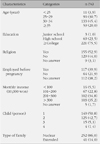Abstract
Purpose
This study aimed to identify the scores of postpartum depression(PPD) on the first day, 1st week, and 6th week after the delivery and to explore their related factors before and after delivery in postpartum women.
Methods
With a survey design, 293 postpartum women were recruited from a postpartum unit, Ilsin Christian hospital in Pusan via convenience sampling and were followed at 1st week and 6th week in the outpatient clinic.
Results
Results showed that the scores of PPD(EPDS score) were low at postpartum 1st day, 1st week and 6th week but prevalence of PPD(EPDS ≥13) was 3.1% at 1st day, 8.2% at 1st week and 7.5% at 6th week, respectively. The pre-delivery factors were experience of depression, and the post-delivery factors were baby's sex(1st day), no caregiver for baby(1st week), and no help and concern for taking care of baby from husband and family(1st day and 6th week). The greater satisfaction with becoming a mother and her life, and greater maternal attachment were related to lower level of PPD at the three time points.
Figures and Tables
References
1. Ahn Y.M., Kim J.H. Comparison of maternal self-esteem, postpartal depression, and family function in mothers of normal and of low birth-weight infants. Journal of Korean Academy of Nursing. 2003. 33(5):580–590.
2. Beck C.T. Predictors of postpartum depression. Nursing Research. 2001. 50(5):275–283.
3. Beck C.T., Gable R.K. Comparative analysis of the performance of the postpartum depression screening scale with two other depression instruments. Nursing Research. 2001. 50(4):242–250.
4. Boyd R.C., Amsterdam J.D. Mood disorders in women from adolescence to late life: An overview. Clinical Obstetrics and Gynecology. 2004. 47(3):515–526.
5. Choi E.S., Oh J.A. A study on the factors related to postpartum depression in postpartum women. Journal of Korean Academy of Women's Health Nursing. 2000. 6(3):358–371.
6. Choi S.H. The relationship among the degrees of life stress, social support and depression in postpartal women. Journal of Korean Academy of Fundamentals Nursing. 2001. 8(2):199–209.
7. Cox J.L., Holden J.M., Sagovsky R. Detection of postnatal depression: Development of the 10-item Edinburgh postnatal depression scale. British Journal of Medical Psychology. 1987. 150:782–786.
8. Gaynes B.N., Gavin N., Maltner-Brody S., Lohr K.N., Swinson T., Gartlehner G. Perinatal depression: Prevalence, screening accuracy, and screening outcomes. Evidence Report/Technology Assessment (Summary). 2005. 119:1–8.
9. Halbreich U. The association between pregnancy processes, preterm delivery, low birth weight, and postpartum depressions - The need for interdisciplinary integration. American Journal of Obstetrics and Gynecology. 2005. 193:1312–1322.
10. Halligan S.L., Murray L., Martins C., Cooper P.J. Maternal depression and psychiatric outcomes in adolescent offspring: A 13-year longitudinal study. Journal of Affective Disorders. 2007. 97:145–154.
11. Han G.E. The relationship of maternal self-esteem and maternal sensitivity with mother-to-infant attachment. 2001. Seoul: Hanyang University;Unpublished master's thesis.
12. Henshaw C., Foreman D., Cox J. Postnatal blues: A risk for postnatal depression. Journal of Psychosomatic Obstetrics and Gynaecology. 2004. 25(3-4):267–272.
13. Hung C.H. Woman's postpartum stress, social support, and health status. Western Journal of Nursing Research. 2005. 27(2):148–159.
14. Josefsson A., Berg G., Nordin C., Sydsjo G. Prevalence of depressive symptoms in late pregnancy and postpartum. Acta Obstetricia et Gynecologica Scandinavica. 2001. 80:251–255.
15. Jung M.H., Kim J.I. A Study on the relationship among prenatal emotional status, preparation for delivery, postpartum social support and postpartum blue. Korean Journal of Women Health Nursing. 2005. 11(1):38–45.
16. Kim J.W., Kim J.H., Eun D.S., Kim H. Psychosocial and obstetric predictors of depressive symptomatology at postpartum 4 weeks. Korean Journal of Obstetrics and Gynecology. 2005. 48(4):901–909.
17. Lee D.T., Yip A.S., Chan S.S., Tsui M.H., Wong W.S., Chung T.K. Postdelivery screening for postpartum depression. Psychosomatic Medicine. 2003. 65:357–361.
18. Müller M.E. A questionnaire to measure mother to infant attach. Journal of Nursing Measurement. 1994. 12(6):67–74.
19. Murray L., Halligan S.L., Adams G., Patterson P., Goodyer I.M. Socioemotional development in adolescents at risk for depression: The role of maternal depression and attachment style. Development and Psychopathology. 2006. 18:489–516.
20. Park S.S., Han K.W. Psychosocial risk factors of postpartum depression. Korean Journal of Psychosomatic Medicine. 1999. 7(1):124–133.
21. Park Y.J., Shin H.J., Ryu H.S., Cheon S.H., Moon S.H. The predictors of postpartum depression. Journal of Korean Academy of Nursing. 2004. 34(5):722–728.
22. Righetti-Veltema M., Bousquet A., Manzano J. Impact of postpartum depressive symptoms on mother and her 18-month-old infant. European Child & Adolescent Psychiatry. 2003. 12:75–83.
23. Song J.E. Predictors of postpartum fatigue between early and late postpartum period in parturient women - divided by 3/4 weeks of postpartum period-. Korean Journal of Women Health Nursing. 2007. 13(4):299–309.
24. Teissedre F., Chabrol H. Detecting women at risk for postnatal depression using the Edinburgh postnatal depression Scale at 2 to 3 days postpartum. Canadian Journal of Psychiatry. 2004. 49:51–54.
25. Webb D.A., Bloch J.R., Coyne J.C., Chung E.K., Bennett I.M., Culhane J.F. Postpartum physical symptoms in new mothers: Their relationship to functional limitations and emotional well-being. Birth. 2008. 35(3):179–187.
26. Yeo J.H. Postpartum depression and its predictors at six months postpartum. Korean Journal of Women Health Nursing. 2006. 12(4):273–280.




 PDF
PDF ePub
ePub Citation
Citation Print
Print







 XML Download
XML Download